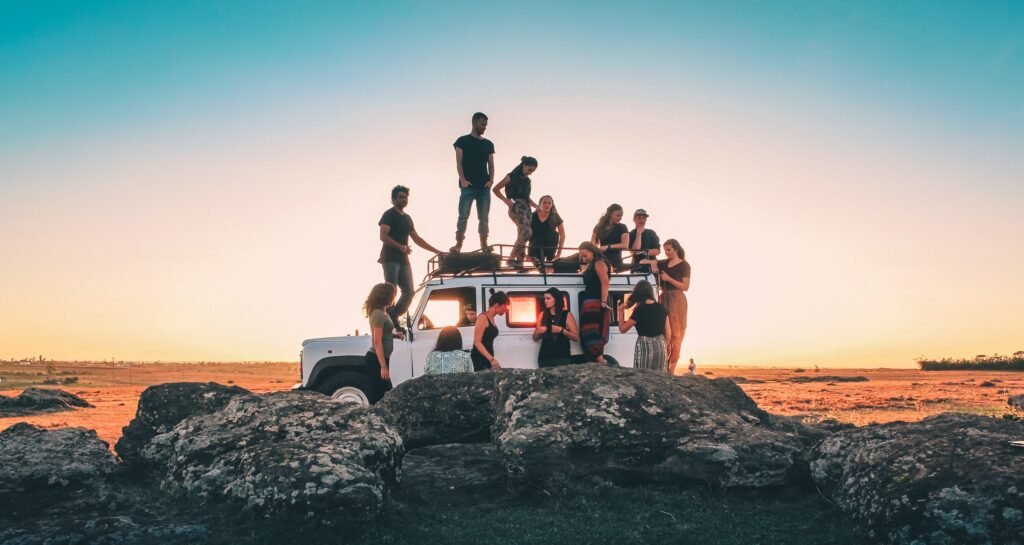In the beginning
Adventure travel is a form of tourism that entails traveling to new and unusual places, participating in activities that are physically demanding, and experiencing things that are different from what one is used to. People are looking for experiences that are more meaningful and genuine, which has led to an increase in the popularity of this kind of travel in recent years. The notion of adventure travel, as well as its advantages and disadvantages, as well as the ways in which it affects the environment, will be discussed in this article.

What exactly does “Adventure Travel” mean?
Activities such as hiking, rock climbing, kayaking, white water rafting, and other activities that require a significant amount of physical exertion are included in the category of tourism known as adventure travel travel.
Exploration and Travel:
This type of tourism is frequently distinguished by its emphasis on the natural environment and the aspiration to experience it in a manner that is more direct and immersive than that of regular tourism. It is possible for it to take place in remote or exotic settings, and it may include interactions with people from various cultures and ways of life.
Benefits of Adventure Travel One of the most significant advantages of adventure travel is the chance it affords for personal development and the finding of one’s own identity. Participating in activities that require a significant amount of physical exertion can assist individuals in developing resiliency, self-confidence, and a sense of success. Additionally, it has the potential to inspire a sense of connectedness to the natural world as well as a more profound respect for the natural world.
Connecting with people of diverse cultures and ways of life may also be accomplished through this method. It is possible to extend one’s viewpoint, enhance one’s knowledge of others, and raise one’s empathy for them by immersing oneself in a foreign culture. Additionally, it may be a means of acquiring new skills and developing a deeper understanding for the various ways of life that exist globally.
The perils of adventure travel Adventure travel may also be dangerous, and those who participate in it need to be aware of the possible risks that are associated with activities that require a lot of physical exertion. Falls, exposure to harsh weather conditions, and mishaps with equipment such as kayaks or climbing ropes are all examples of the types of dangers that might occur. Falls can result in serious injuries or even death.
Additionally, if it is not carried out in a responsible and sustainable manner, adventure travel has the potential to have a detrimental effect on the natural environment. In the event that they are not managed appropriately, activities such as hiking and camping have the potential to cause damage to sensitive ecosystems. Additionally, the use of motorized vehicles can add to the pollution of the air and the noise.
Repercussions for the Natural World:
The environment may be affected in both good and bad ways by tourists who engage in adventure travel. The good aspect of adventure travel is that it may be a means of promoting conservation and sustainable development in regions that could otherwise be endangered by practices that are not sustainable, such as mining or forestry. Local communities can be encouraged to respect and maintain their natural resources through the provision of economic incentives for the preservation of natural places, which can be accomplished through adventure tourism.
However, if it is not carried out in a responsible and sustainable manner, adventure travel can also have a harmful influence on the environment. In the event that they are not managed appropriately, activities such as hiking and camping have the potential to cause damage to sensitive ecosystems. Additionally, the use of motorized vehicles can add to the pollution of the air and the noise. Additionally, the construction of infrastructure to facilitate adventure travel can result in the fragmentation of habitats and the loss of biodiversity.
Varieties of Traveling for Adventure:
Depending on the activities that are engaged and the location that is being visited, adventure travel may take many different shapes. Among the most frequent varieties are: *
When you go trekking or hiking, you are going to be visiting isolated and rough terrain on foot, and you will often be carrying a backpack and using camping equipment. The Himalayas, the Andes, and the Appalachian Trail are considered to be among the most popular trekking locations.
Climbing and mountaineering are two activities that entail climbing mountains and peaks with the use of specialized gear such ropes, harnesses, and crampons. The mountains of Mount Everest, Kilimanjaro, and Denali are among the most popular climbing locations.
Activities that fall under the category of “water sports” include rafting, surfing, kayaking, and scuba diving, among others. Countries such as Costa Rica, Hawaii, and the Great Barrier Reef in Australia are among the most popular places for water sports.
This activity includes exploring terrain on two wheels, either on highways or off-road routes. Mountain biking and cycling are two examples of this. The Tour de France route, the Appalachian Trail, and the Swiss Alps are considered to be among the most popular locations for cyclists.
In the course of wildlife safaris, participants see and photograph many species of animals in their natural environments. The continents of Africa, South America, and Alaska are among the most popular places for wildlife safaris.
In terms of mental health, the advantages of adventure travel:
In addition to the favorable effects it has on one’s physical health, it may also have a beneficial effect on one’s mental health. A number of studies have demonstrated that participating in activities that take place outside may effectively alleviate feelings of stress and anxiety, enhance mood and self-esteem, and foster mindfulness and a sense of well-being. Adventure travel may also give an opportunity to disengage from technology and everyday routines, which can be excellent for mental health. This can be gained via the experience of traveling.
Experience Travel That Is Eco-Friendly:
As was said previously, adventure travel has the potential to have adverse effects on the state of the environment if it is not carried out in a responsible and sustainable manner. A sustainable approach to adventure travel comprises reducing the amount of damage done to the environment, providing assistance to the people that are visited, and advocating for conservation and preservation. When it comes to adventure travel, some strategies to conduct sustainable travel include:
by selecting tour operators that are reputable and who have an emphasis on conservation and sustainability.
minimizing waste by carrying containers that can be reused, lowering the amount of plastic used, and disposing of garbage in an appropriate manner.
demonstrating respect for the local culture and customs, as well as providing assistance to the local community and businesses.
When camping and hiking, it is important to adhere to the principles of Leave No evidence, which include minimizing the influence on the environment and leaving no evidence of human presence.
Safe Travel for Thrill Seekers
Especially when it comes to sports like climbing, kayaking, and diving, adventure travel can be associated with a number of potential dangers and safety issues. It is essential for adventure travelers to take the necessary steps to ensure their safety and to be ready for any unexpected events that may arise.
A few safety advice include conducting research about the activity and the location in advance in order to have an understanding of the potential dangers and hazards.
It is important to select tour operators and guides that are reliable, knowledgeable, and take safety seriously.
When participating in the activity, it is important to wear the right clothing and equipment, such as helmets, harnesses, and lifelines.
The safety recommendations and instructions that are supplied by the guides or instructors should be followed.
Acquire a first aid kit and be familiar with how to utilize it.
Ensure that you are well-prepared for any unexpected events by having a satellite phone or an emergency beacon with you and being aware of the location of the closest medical institution near you.
Avoid taking risks that aren’t essential, and be aware of when to retrace your steps if the situation becomes dangerous.
When adventure travelers take these safety procedures, they may reduce the hazards they face and enjoy their experiences without risking their safety.
Final Thoughts
Discovering the world and putting oneself through mental and physical challenges may be accomplished in a way that is both distinctive and satisfying. On the other hand, it is essential to engage in responsible and environmentally conscious travel practices, as well as to take the necessary steps to protect oneself from any dangers and to guarantee a pleasant and secure trip. Adventure travelers have the capacity to enjoy experiences that are meaningful and significant while also encouraging conservation and safeguarding the environment if they place a priority on safety, sustainability, and ethical travel practices before anything else.
Final Thoughts:
The fact that it places an emphasis on genuine and immersive experiences has contributed to the rise in popularity of this style of tourism over the past several years. Although there are numerous advantages that may be gained from it, such as personal development and the sharing of cultural ideas, it is essential to be aware of the possible dangers and the effects that it may have on the environment. By engaging in ethical and sustainable travel practices, adventure travelers may guarantee that their experiences have a beneficial influence not just on themselves but also on the communities and surroundings that they visit.

